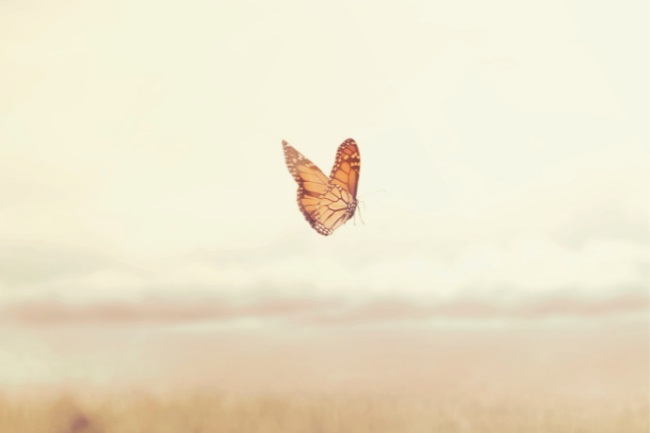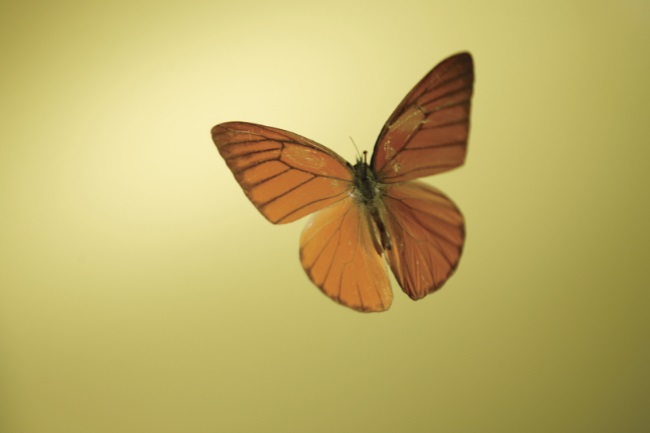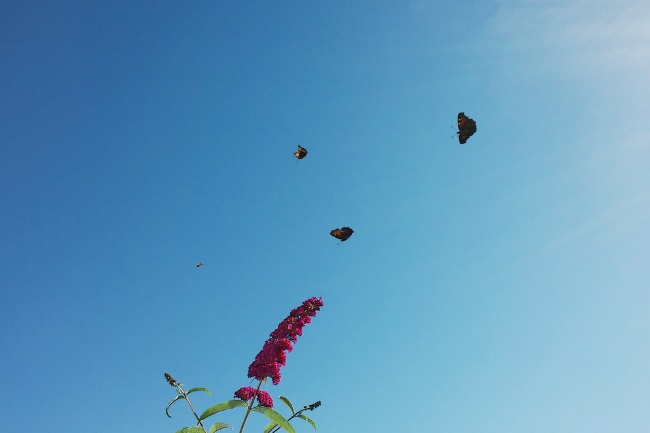Butterflies can fly amazingly high for such tiny species, up to 3,500m. They often do this as part of their migration.
Contents
How does a butterfly fly?

Butterflies may seem like flimsy fliers but they are surprisingly versatile, able to fly thousands of miles and rise up several kilometres into the sky.
They achieve all this by clever use of their wings, which have evolved perfectly for the job. Their beautiful large wings are so massive compared to their size in order to be able to lift them gracefully off the ground.
As they fly they contract their body, pulling their wings up and round in a figure of eight. The wings also meet above their head, forming a kind of air tunnel that helps propel them forwards like a little jet pack.
For their truly awe-inspiring journeys, however, they tend to utilise the prevailing wings to pick up their pace and send them racing to their destination.
Also read: What are Butterfly Wings Made of? (The Anatomy Explained)
How high does a butterfly fly?

There are a number of butterflies that spend part or all of their lives high up in mountains. Therefore they are flying much higher than many other species, even though they may not be flying high off the ground.
Marco Polo’s clouded yellow and the Nepal argus are the two of the highest living butterfly species in the world, spending their days flitting around at 4,000m and 4,500m respectively.
| Butterfly Species | Flight Altitude Range |
|---|---|
| Monarch Butterfly | Monarchs can fly at altitudes of up to 3,000 to 4,000 feet |
| Painted Lady Butterfly | Painted Ladies can fly at altitudes of up to 10,000 feet |
| Swallowtail Butterfly | Swallowtails generally fly at lower altitudes, up to 500 feet |
| Blue Morpho Butterfly | Blue Morphos fly in the lower canopy of the rainforest |
| Cabbage White Butterfly | Cabbage Whites fly at low altitudes, often near the ground |
At these heights, the butterflies have to contend with all the same challenges as other living things living at altitude, such as low oxygen levels and cold.
When it comes to butterflies flying high above the ground many species can rise surprisingly high even when they normally spend their time at much lower altitudes.
The highest altitude a butterfly has been observed at is around 3,300m, a group of butterflies spotted by fighter pilots. Monarch butterflies have also been spotted flying up close to the top of the Empire state building.
Why do butterflies fly up high?
In general, it benefits butterflies to stay close to the ground. Firstly the ground is where they find their food, and they need to feed regularly to survive.
It’s also the best place to find a mate, which is the main aim of all butterflies. And finally, it is easier for them to hide and escape from predators on the ground.
Therefore there are few reasons to head up high into the air aside from for migration, allowing them to head out across vast distances in a much speedier way than if they stayed close to the ground.
Also read: Do Butterflies Mate for Life? Eternal Love or…
Do butterflies fly higher when they’re migrating?

In general, butterflies do fly higher when they are migrating. This is because they are taking advantage of suitable conditions to speed their journey along.
Studies of the migrations of the painted lady butterflies have found that this little species can cover over 100 miles in a day, something that would not be feasible without the wind at their backs.
| Butterfly Species | Migration Distance |
|---|---|
| Monarch Butterfly | Monarchs undertake long-distance migrations of up to 3,000 miles |
| Painted Lady Butterfly | Painted Ladies migrate over long distances, up to 9,000 miles |
| Swallowtail Butterfly | Swallowtails generally do not undertake long migrations |
| Blue Morpho Butterfly | Blue Morphos do not migrate as extensively as other species |
| Cabbage White Butterfly | Cabbage Whites have limited migration capabilities |
Monarch butterflies to tend to rest and feed when the winds are not suitable to help them on their journey, instinctively knowing how to take the best advantage of the weather conditions.
Also read: Do Dragonflies Migrate or Hibernate? (Surviving Winter)
Can a butterfly fly in the wind?
Generally, you’ll see a few butterflies out on a windy day. This is in part because the wind buffets them around, making it hard to land on flowers and putting them at risk of injury or of being caught.
Flying into the wind is particularly tricky, and a butterfly can’t make progress unless it can fly faster than the wind is blowing. Most butterflies can fly roughly between 3-30 miles per hour. So in order for them to beat the wind, they need to be a species that can fly faster than it.
However, butterflies don’t always avoid the wind. During migration for example species will fly up high into prevailing winds to push them along.
Can a butterfly fly in rain?

The weight of the average raindrop is 500mg while a butterfly can be around 70mg. This means that being hit even by a single raindrop can be a serious assault on a butterfly.
Not only will it require additional energy to fly in these conditions, but the raindrops could also unbalance them, causing the butterfly to crash land.
During rain butterflies tend the close their wings and hunker down in vegetation until it passes.
Can a butterfly fly in the cold?
Butterflies are insects, and this means they cannot produce their own heat. Because of this high altitude flying comes with its own risks as the air becomes colder the higher they go.
This means that they often can’t remain high for very long, and must come down to rest and warm-up. Some warmth is however generated through the flapping of their wings, which may help them remain high for longer.
Also read: Here’s How and What a Butterfly Eat in The Winter
Invisible insects
Pick any piece of sky, and however cloud-free and empty it may appear, and it can actually be filled with hundreds and thousands of insects, high above and well out of sight.
Most of these tiny travellers are taking advantage of prevailing winds to travel to new areas in search of food or breeding sites. We may think that we’ve mastered the skies with our air travel but it’s actually the species we barely notice when they are on the ground that is busy exploring the world.

